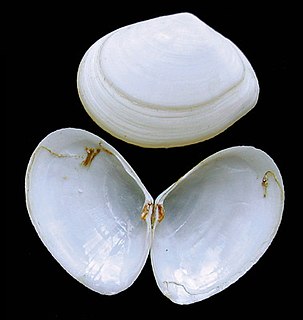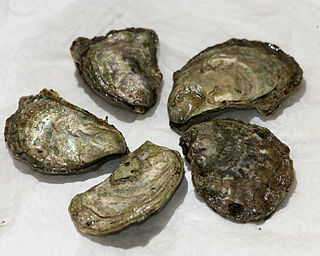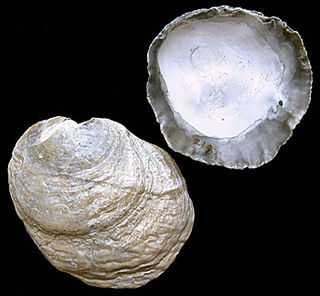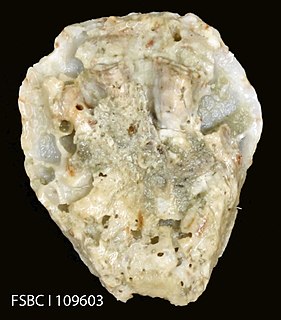
A pearl is a hard, glistening object produced within the soft tissue of a living shelled mollusk or another animal, such as fossil conulariids. Just like the shell of a mollusk, a pearl is composed of calcium carbonate in minute crystalline form, which has deposited in concentric layers. The ideal pearl is perfectly round and smooth, but many other shapes, known as baroque pearls, can occur. The finest quality of natural pearls have been highly valued as gemstones and objects of beauty for many centuries. Because of this, pearl has become a metaphor for something rare, fine, admirable and valuable.

The trombone is a musical instrument in the brass family. As with all brass instruments, sound is produced when the player's vibrating lips (embouchure) cause the air column inside the instrument to vibrate. Unlike most other brass instruments, which have valves that, when pressed, alter the pitch of the instrument, trombones instead have a telescoping slide mechanism that varies the length of the instrument to change the pitch. However, many modern trombone models also have a valve attachment which lowers the pitch of the instrument. Variants such as the valve trombone and superbone have three valves similar to those on the trumpet.

Bivalvia, in previous centuries referred to as the Lamellibranchiata and Pelecypoda, is a class of marine and freshwater molluscs that have laterally compressed bodies enclosed by a shell consisting of two hinged parts. Bivalves as a group have no head and they lack some usual molluscan organs like the radula and the odontophore. They include the clams, oysters, cockles, mussels, scallops, and numerous other families that live in saltwater, as well as a number of families that live in freshwater. The majority are filter feeders. The gills have evolved into ctenidia, specialised organs for feeding and breathing. Most bivalves bury themselves in sediment where they are relatively safe from predation. Others lie on the sea floor or attach themselves to rocks or other hard surfaces. Some bivalves, such as the scallops and file shells, can swim. The shipworms bore into wood, clay, or stone and live inside these substances.

Scallop is a common name that is primarily applied to any one of numerous species of saltwater clams or marine bivalve mollusks in the taxonomic family Pectinidae, the scallops. However, the common name "scallop" is also sometimes applied to species in other closely related families within the superfamily Pectinoidea, which also includes the thorny oysters.

The Schrader valve is a type of pneumatic tire valve used on virtually every motor vehicle in the world today. The Schrader company, for which it was named, was founded in 1844 by August Schrader. The original Schrader valve design was invented in 1891, and patented in the United States in 1893.

The Honda D series inline-four cylinder engine is used in a variety of compact models, most commonly the Honda Civic, CRX, Logo, Stream, and first-generation Integra. Engine displacement ranges between 1.2 and 1.7 liters. The D Series engine is either SOHC or DOHC, and might include VTEC variable valve timing. Power ranges from 66 PS (49 kW) in the Logo to 130 PS (96 kW) in the Civic Si. D-series production commenced 1984 and ended 2005. D-series engine technology culminated with production of the D15B 3-stage VTEC (D15Z7) which was available in markets outside of the United States. Earlier versions of this engine also used a single port fuel injection system Honda called PGM-CARB, signifying the carburetor was computer controlled.

The Honda K-series engine is a line of four-cylinder four-stroke car engine introduced in 2001. The K-series engines are equipped with DOHC valvetrains and use roller rockers to reduce friction. The engines use a coil-on-plug, distributorless ignition system with a coil for each spark plug. This system forgoes the use of a conventional distributor-based ignition timing system in favor of a computer-controlled system that allows the ECU to control ignition timings based on various sensor inputs. The cylinders have cast iron sleeves similar to the B- and F-series engines, as opposed to the FRM cylinders found in the H- and newer F-series engines found only in the Honda S2000.
A mollusc valve is each articulating part of the shell of a mollusc. Each part is known as a valve or in the case of chitons, a "plate". Members of two classes of molluscs: the Bivalvia (clams) and the Polyplacophora (chitons) have valves.
Cliona californiana, the yellow boring sponge, boring sponge or sulphur sponge, is a species of demosponge belonging to the family Clionaidae. It is native to the north-eastern Pacific Ocean and burrows into the shell valves of bivalve molluscs.

A bivalve shell is part of the body, the exoskeleton or shell, of a bivalve mollusk. In life, the shell of this class of mollusks is composed of two hinged parts or valves. Bivalves are very common in essentially all aquatic locales, including saltwater, brackish water, and freshwater. The shells of bivalves commonly wash up on beaches and along the edges of lakes, rivers, and streams. Bivalves by definition possess two shells or valves, a "right valve" and a "left valve", that are joined by a ligament. The two valves usually articulate with one another using structures known as "teeth" which are situated along the hinge line. In many bivalve shells, the two valves are symmetrical along the hinge line—when truly symmetrical, such an animal is said to be equivalved; if the valves vary from each other in size or shape, inequivalved. If symmetrical front-to-back, the valves are said to be equilateral, and are otherwise considered inequilateral.

Ostrea lurida, common name the Olympia oyster, after Olympia, Washington in the Puget Sound area, is a species of edible oyster, a marine bivalve mollusk in the family Ostreidae. This species occurs on the northern Pacific coast of North America. Over the years the role of this edible species of oyster has been partly displaced by the cultivation of non-native edible oyster species.

The dredge oyster or Bluff oyster, Ostrea chilensis, known in Chile as ostra chilena, the Chilean oyster, is a species of marine bivalve mollusc in the family Ostreidae.

The Pectinoidea are a superfamily of marine bivalve molluscs, including the scallops and spiny oysters.

Pododesmus patelliformis, the ribbed saddle-oyster, is a species of bivalve mollusc in the family Anomiidae. It is found in the north east Atlantic Ocean.

Pectinida is a taxonomic order of large and medium-sized saltwater clams, marine bivalve molluscs, commonly known as scallops and their allies. It is believed that they began evolutionarily in the late Middle Ordovician epoch; many species, of course, are still extant.

Ostrea equestris, commonly known as the crested oyster or horse oyster, is a species of bivalve mollusc in the family Ostreidae. It can be found along the Atlantic coast of North and South America, ranging from Virginia to Patagonia.

Pinctada mazatlanica is a species of tropical marine bivalve mollusc in the family Pteriidae, the pearl oysters. It is known by the English common names pearl oyster, Mazatlan pearl oyster, and Panama pearl oyster. Spanish common names include madre perla, and ostra perlifera panameña. This mollusc was first described to science in 1856 by conchologist Sylvannus Charles Thorp Hanley. Pinctada mazatlanica produces gem-quality pearls and was the basis of a pearling industry in the Gulf of California for centuries.
Pinctada fucata, the Akoya pearl oyster (阿古屋貝), is a species of marine bivalve mollusc in the family Pteriidae, the pearl oysters. Some authorities classify this oyster as Pinctada imbricata fucata. It is native to shallow waters in the Indo-Pacific region and is used in the culture of pearls.

Pteria penguin, commonly known as the penguin's wing oyster, is a species of marine bivalve mollusc in the family Pteriidae, the pearl oysters. It is native to the western and central Indo-Pacific region and is used for the production of cultured pearls. The generic name comes from Greek πτερον (pteron) meaning wing.
Pinctada longisquamosa, sometimes called scaly pearl osters, are a small species of pearl oyster found in the western Atlantic. They are distinguished by unique prismatic shell structures which protrude from the outer shell.















